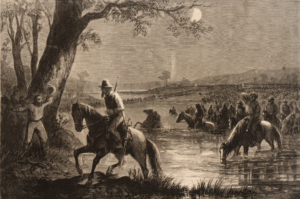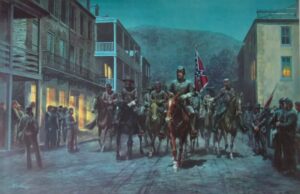General R. E. Lee’s Maryland Campaign: Objective #2

In addition to pecking for a fight with his Union opponent, General R. E. Lee had a secondary objective in his Maryland Campaign. He was seeking provisions for his army in the hope of giving the northern Virginia farmers a badly needed break.[1] Was this strategically sound?
It was a strategically sound goal. There was a lack of food in Virginia.[2] Since July 1861, northern Virginia had been feeding two armies. That’s a lot!
What’s the catch? It wasn’t achievable. Lee wasn’t able to gather enough resources for his campaigning army, nor was he able to give the Virginia farmers much of a break. Here’s why.
On September 4, prior to Lee crossing the Potomac at Leesburg, Virginia, a Confederate Maryland officer warned him they were crossing into pro-Union Maryland territory. Colonel Bradley T. Johnson grew up in Maryland. He now served with Lt. Gen. Thomas Jackson. Johnson first spoke with Jackson. The general asked Johnson to give an assessment of the impending campaign:
“I impressed upon him [Jackson] emphatically the fact that a large portion of the people were ardent Unionists that perhaps an equal number were equally ardent sympathizers with the Confederate cause still they had been since June 1861 so crushed beneath the over whelming military force that they could not be expected to afford us material aid until we gave them assurance of an opportunity for relief by an occupation promising at least some permanence . . .”[3]
Jackson then invited Johnson to accompany him to Lee’s headquarters in Leesburg and requested the colonel repeat their conversation. Colonel Johnson “informed him [Lee] that his army would be marching into a region that had pro-Union sentiments. These civilians would not willingly hand over material aid.”[4] There were more Confederate sympathizers near the Williamsport crossing.
Lee politely listened to Johnson as Jackson fell asleep upright. The commanding general replied, “[w]hen I left Richmond, I told the President that I would, if possible, relieve Virginia of the pressure of these two armies. If I cross here, I may do so at the cost of men but with a saving of time. If I cross at Williamsport, I can do so with saving of men but at cost of time. . .” The Army of Northern Virginia began crossing the Potomac at Leesburg on September 5.[5]

Lee’s campaign soon began to unravel. With his policy of mitigating the “evils” (violence) of war, he couldn’t get enough food for his hungry army from pro-Union citizens.[6] He had no intention of allowing his men to bleed the Marylanders. Making matters worse, even the few Southern Maryland sympathizers didn’t offer much help. The majority closed their doors. Lee reported that millers and “others” refused to aid his army. Farmers, too, had not yet harvested their wheat, and some had driven their cattle to Pennsylvania.[7] It was slim pickings.
Without enough food, on September 9, four days into his campaign, Lee made significant changes in his operation. He began transporting supplies from the Shenandoah Valley in Virginia to his army in Maryland.[8] He then changed up his army’s system. Rather than two corps (easier to command), he divided his army into independent divisions (reminiscent of Seven Days). Dividing his force allowed the divisions to forage for what little food was available. The downside to the multiple “wing” system left his army exposed. It also meant keeping track of his generals was more difficult. Only four days after crossing into Maryland, Lee had lost control of the campaign, at least for a time.[9]
The overall total of resources (edibles and non-edibles) bought with Confederate money wasn’t much. The first couple of divisions that marched into Maryland got enough food and clothing to sustain them for the campaign. Lee calculated his army acquired 4,000–5,000 pairs of shoes. That was enough to don one division.[10] The army found some forage for their animals. But Lee noted that only 1,500 barrels of flour, a little beef, and a small amount of bacon were procured.[11] There also wasn’t enough clothing in Maryland “to supply the men,” and with the cold weather coming Lee noted that his men lacked underclothing. The biggest take-away was in weapons. The Confederates confiscated a fair quantity when the armory at Harpers Ferry was captured: 73 artillery pieces, 13,000 “small-arms, and a large quantity of military stores.”[12] Still, food stores were much more important to the hungry soldiers and animals.[13]

You can read Lee’s Maryland Campaign Objectives parts 1 and 3 here.
[1] R. E. Lee to Davis, Leesburg, VA, September 4, 1862, O.R., Ser. 1, vol. 19, pt. 2, 591–92.
[2] D. Scott Hartwig, To Antietam Creek, 48. Stephen Sears, Landscape Turned Red: The Battle of Antietam, 63–6.
[3] See General Bradley T. Johnson, “Reunion of Virginia Division Army of Northern Virginia Association,” SHSP vol. 12 (January to December 1884): 503–04. https://www.google.com/books/edition/Southern_Historical_Society_papers/NX-ja65vuXUC?hl=en&gbpv=1&bsq=Johnson%20. Joseph Harsh has an interesting discussion on Johnson’s conversation with Lee, see Taken at the Flood, 81–3. There is an interesting side note about Johnson. In 1864, when Lieutenant General Jubal Early carried out a raid into Pennsylvania, Johnson was the officer ordered to burn Chambersburg, see Ezra Warner, Generals in Gray, 157.
[4] Johnson, “Reunion of Virginia Division Army of Northern Virginia Association,” SHSP vol. 12 (January to December 1884): 503–04.
[5] Ibid.
[6] Once the war started in 1861, Lee believed that both sides should be compelled to “mitigate its evils.” See Jones, Life and Letters, 129–30.
[7] R. E. Lee to Davis, New Fredericktown, MD, September 9, 1862, O.R., Ser. 1, vol. 19, pt. 2, 602.
[8] Ibid.
[9] In a later blog this month, I will discuss when Lee regains control of the campaign.
[10] For number of shoes, see R. E. Lee to Colonel A. C. Myers, Quartermaster-General, New Martinsburg, VA, September 21, 1862, O.R., Ser. 1, vol. 19, pt. 2, 614.
[11] R. E. Lee to Davis, Hagerstown, Maryland, September 12, 1862, in Long, Memoirs of Robert E. Lee, 538–39. For millers and farmers, see R. E. Lee to Davis, New Fredericktown, MD, September 9, 1862, O.R., Ser. 1, vol. 19, pt. 2, 602. See also, James V. Murfin, The Gleam of the Bayonets: The Battle of Antietam and Robert E. Lee’s Maryland Campaign, September 1862, 107.
[12] A. L. Long, Memoirs, 529. The Confederates captured Harpers Ferry September 15 and 16, 1862 and abandoned it two days later.
[13] Illustrations: Confederates crossing into Maryland, 1862 by Allen Christian Redwood; Second Drawing, Confederates ford the Potomac, September 1862. This drawing is by Thomas Nast. For illustrations one and two see, Alex Rossino (9/1/2024) As Memory Serves: Lee’s 1862 Trek Into Maryland, In Artists’ Eyes. HistoryNet Retrieved from https://www.historynet.com/as-memory-serves-lees-1862-trek-into-maryland-in-artists-eyes/. The third illustration is a painting depicting Lt. Gen. Stonewall Jackson entering Harpers Ferry, September 1862, painting by Mort Kunstler.
I’m not sure where this stuff is coming from, but Lee did not divide his army into divisions. It entered Maryland in a state of flux between formal corps and divisions. Divisions subject to Lee’s command alone included R.H. Anderson’s, Lafayette McLaws’s, John Walker’s, and, after September 10, D.H. Hill’s. The remaining divisions of the army continued to operate under the command of James Longstreet and Thomas Jackson.
As for Bradley Johnson’s recollections, they are deceptive to an extreme. As I document in Their Maryland, Johnson’s actions are what we should focus on, not his postwar fabrications. Johnson did everything he could to recruit troops for the Army of Northern Virginia in Frederick, even to the point of calling for Marylanders to “rise at once in arms, and strike for liberty and right” on Sept. 8.
I don’t think a man who issues a call for rebellion is someone who believed at the time that Marylanders would not respond. It just doesn’t add up.